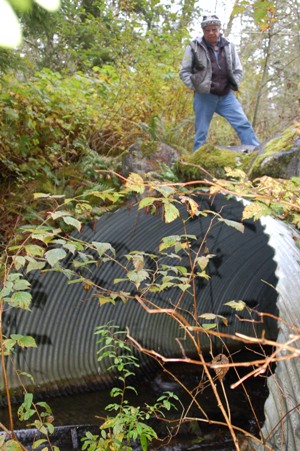By Billy Frank, Jr., Chairman, Northwest Indian Fisheries Commission
OLYMPIA – A little creek in eastern Washington was at the center of an important water quality ruling recently by the Washington State Supreme Court, reaffirming the state’s right to regulate nonpoint sources of pollution in streams. Nonpoint pollution takes many forms, such as higher water temperatures, sediment, stormwater runoff, fecal coliform bacteria from failing septic systems and agricultural practices.
For 10 years the state Department of Ecology (DOE) tried to work with rancher Joseph Lemire to keep his 29 head of cattle out of Pataha Creek, a small stream that runs through his property near Dayton. Lemire’s cattle had unrestricted access to the creek, leading to manure in the stream, eroded streambanks and increased sediment in the creek.
When DOE finally ordered Lemire to stop polluting by fencing cows out of the creek, the rancher appealed, claiming that a fence would restrict use of his land and therefore was an unlawful “taking” of his property. The state Supreme Court disagreed in an 8-1 ruling.
The fact that it took nearly a decade to get one rancher to do the right thing is made even more disturbing because Pataha Creek was selected as a model watershed in 1993 by the Bonneville Power Administration. BPA and other agencies have spent hundreds of thousands of dollars working with ranchers and farmers to provide everything from streamside fencing to tree and shrub planting to help improve the creek.
Twenty years of voluntary efforts haven’t turned the tide of nonpoint pollution in many Washington watersheds. As the Lemire example shows, sometimes it takes more than money and voluntary efforts to protect our resources. And sometimes, all it takes to jeopardize our work is one landowner who’s not willing to do the right thing.
Thankfully, the state has the authority to control these sources of pollution, and was willing to take the case to the state Supreme Court to defend it. That’s encouraging, because the ruling wasn’t anything new. It’s just a matter of the state having the will to use its authority to regulate nonpoint source pollution. We shouldn’t have to look to the courts for leadership.
Let’s hope the court’s ruling will translate into better water quality protection on this side of the mountains, too. Our treaty rights depend on it.
Our treaties guaranteed us the continued right to fish and gather shellfish, which depends on good water quality to ensure healthy salmon habitat and shellfish that are safe to eat. Nonpoint sources of water pollution constantly threaten our natural resources. When a shellfish harvest area is closed because of pollution, or salmon runs are reduced because of poor water quality, our treaty rights are denied altogether.
We all live downstream – every one of us. We need to keep that in mind and work together to restore and protect water quality in this state.



